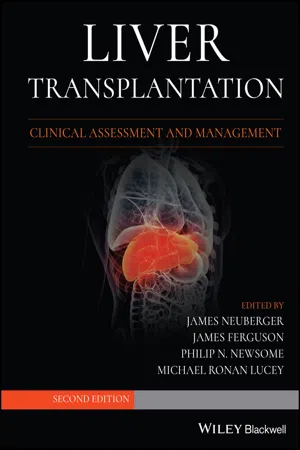
Liver Transplantation
Clinical Assessment and Management
- English
- ePUB (mobile friendly)
- Available on iOS & Android
Liver Transplantation
Clinical Assessment and Management
About this book
Explore this practicaland step-by-step guide to managing liver transplant patients from leading internationalcliniciansin Hepatology
The newly revised Second Edition of Liver Transplantation: Clinical Assessment and Management deliversexpert clinical guidance on best practices in managing the care of liver transplant patients.Authors are all experts in theirfield and cover a world-wide perspective.Organizedin an accessible, stepwise fashion and packed with text featuressuch askey points, the book covers all critical areasof each stage oftheliver transplantjourney, from assessment, to management on the list, to long term care.
Readers will learn when to refer a patient for liver transplantation, how to assess a potential liver transplant recipient, learn the principles of the procedure and thelong termmanagement of the transplant recipient. Liver Transplantation providesthe entire hepatology and surgical team the information required for a sound understanding of the entire procedure, from pre- to post-operative care and management.
Clinically oriented and management-focused, the book is far more accessible than the liver transplant sections in traditional hepatology textbooks. Readers will also enjoy:
- A thorough discussion of when to refer a patient for liver transplantation, including general considerations and the use and abuse of prognostic models
- An exploration of the selection, assessment, and managementof patients on the transplant list, including how to manage a patient with chronic liver disease while on the waiting list
- A treatment of liver transplantation for acute liver failure(ALF), including assessmentandmanagement of ALF patients on the transplant waiting list
- A discussion of care of the liver transplant recipient after the procedurein theshort and long term
Perfect forgastroenterologists, hepatologists, andsurgeonsand other health care professionalsmanagingpatients with liver disease who are awaiting, undergoingand followingliver transplantation, Liver Transplantation: Clinical Assessment and Management will also earn a place in the libraries ofmedical students, residents, internal medicine physicians, and GI/Hepatology traineesand all health care professionals providing clinical care to people with liver disease, before, during and after transplantation.
Frequently asked questions
- Essential is ideal for learners and professionals who enjoy exploring a wide range of subjects. Access the Essential Library with 800,000+ trusted titles and best-sellers across business, personal growth, and the humanities. Includes unlimited reading time and Standard Read Aloud voice.
- Complete: Perfect for advanced learners and researchers needing full, unrestricted access. Unlock 1.4M+ books across hundreds of subjects, including academic and specialized titles. The Complete Plan also includes advanced features like Premium Read Aloud and Research Assistant.
Please note we cannot support devices running on iOS 13 and Android 7 or earlier. Learn more about using the app.
Information
Part 1
When to Refer a Patient for Liver Transplantation
1
Overview on Organ Donation and Liver Transplantation
Key points
- Liver disease and its consequences are a major cause of death globally.
- Many patients with cirrhosis die from non‐hepatic causes.
- The causes of liver failure vary between countries, but alcohol and NAFLD are the major causes of cirrhosis and liver failure in the developed world.
- ALD and non‐specific cirrhosis have the worst prognosis, with the outcome of the former being dependent on whether the patient continues to drink alcohol.
- Only a small proportion of those dying from liver failure are suitable for consideration for liver transplantation.
- Rates of deceased and living organ donation vary between countries.
The global burden of liver disease
| Cirrhosis and the liver | HCC | ||||
|---|---|---|---|---|---|
| Global rank | Deaths (000s) | % of total deaths | CDR (per 100,000 population) | Deaths (000s) | |
| World | 11 | 1162 | 2.1 | 15.8 | 788 |
| East Asia and Pacific | 13 | 328 | 2.0 | 14.4 | 547 |
| Europe and Central Asia | 17 | 115 | 1.2 | 12.7 | 78 |
| Latin America and Caribbean | 9 | 98 | 2.7 | 15.6 | 33 |
| Middle East and North Africa | 8 | 77 | 3.5 | 18.2 | 24 |
| North America | 12 | 50 | 1.7 | 14.0 | 27 |
| South Asia | 10 | 314 | 2.5 | 18.0 | 38 |
| Sub‐Saharan Africa | 16 | 179 | 1.9 | 17.9 | 42 |
What causes death in patients with liver disease?
Table of contents
- Cover
- Table of Contents
- Title Page
- Copyright Page
- List of Contributors
- Foreword to the Second Edition
- Foreword to the First Edition
- Preface
- Abbreviations
- Part 1: When to Refer a Patient for Liver Transplantation
- Part 2: Selection, Assessment, and Management on the List
- Part 3: Transplantation for Acute Liver Failure
- Part 4: Donation and Allocation
- Part 5: Care of the Liver Transplant Recipient
- Postscript
- Index
- End User License Agreement